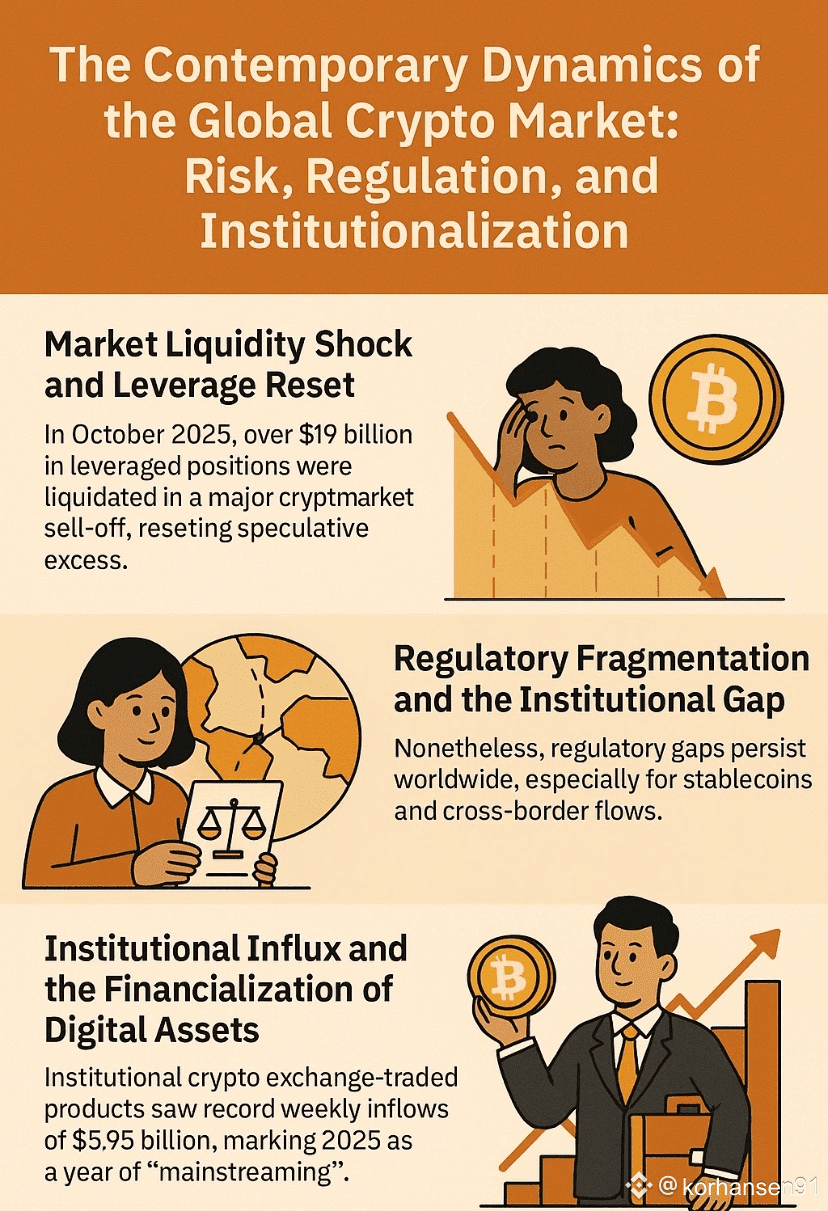#Write2Earn The global crypto economy of 2025 has entered a decisive phase of structural transformation, marked by intensified volatility, tightening regulation, and accelerating institutional integration. What began as a decentralized experiment in digital value has matured into a complex, hybrid financial ecosystem that both mirrors and challenges the traditional economy. Over the past decade, the market’s exponential growth has brought not only innovation lol but also systemic stress from speculative excesses and liquidity shocks to fragmented governance and cross-border inconsistencies.
These phenomena reveal an industry navigating between autonomy and assimilation, where every disruption doubles as an opportunity for reinvention. Beyond numbers and charts, the crypto market now reflects a deeper psychological and sociotechnical evolution: the migration from speculative enthusiasm toward measured legitimacy. Against this backdrop, the following analysis explores three interrelated dimensions risk, regulation, and institutionalization to assess how the digital-asset ecosystem is simultaneously maturing and redefining global financial order.
1. Market Liquidity Shock and Leverage Reset
In October 2025, the crypto ecosystem experienced one of its largest single-day liquidations in recorded history — approximately USD 19 billion in leveraged positions were unwound across major exchanges. Bitcoin’s price declined by nearly 14 %, briefly touching USD 104 800 (Reuters, 2025). This event, colloquially referred to by traders as October’s Black Friday, represented more than a technical correction; it was a psychological purge of speculative excess. From a behavioral-finance perspective, such cascading liquidations reveal a cyclical truth: markets often oscillate between over-confidence and panic. The excessive use of leverage in perpetual futures magnified systemic fragility, while the liquidation wave restored a healthier equilibrium of collateralization. Analysts now interpret the event as a necessary reset an unpleasant but ultimately stabilizing purge that eliminates over-extended positions and restores investor discipline.
This episode underscores the importance of liquidity governance in decentralized markets. Projects aiming to develop DeFi infrastructure or risk-management tools must increasingly consider how algorithmic liquidation engines, collateral thresholds, and cross-margin mechanisms interact with human psychology during periods of volatility.

2. Regulatory Fragmentation & Institutional Gap
A concurrent debate gaining momentum centers on the regulatory architecture of global crypto markets. The Financial Stability Board (FSB) recently warned of “significant gaps” in international coordination, particularly regarding stablecoins and cross-border digital-asset flows (FSB, 2025). Despite the market surpassing USD 4 trillion in capitalization, most jurisdictions remain fragmented in their legal definitions of digital assets and custodial obligations. This regulatory ambiguity produces both risk and innovation space. On one hand, the absence of consistent rules exposes investors to opaque practices and jurisdictional arbitrage. On the other hand, it provides fertile ground for experimental tokenomics, new lending protocols, and synthetic-asset models that would otherwise be constrained under traditional financial law. For research and project development, this duality demands nuanced strategic thinking: sustainable innovation requires engagement with policy frameworks rather than evasion of them. Projects that build compliance-by-design architectures integrating identity verification, transparent auditing, and automated tax reporting will likely define the next era of institutional blockchain adoption.
3. Institutional Influx and the Financialization of Digital Assets
Parallel to these structural debates, 2025 has seen a dramatic increase in institutional participation. Global crypto exchange-traded products (ETPs) attracted nearly USD 5.95 billion in a single week (Reuters, 2025), marking a record inflow largely concentrated in Bitcoin and Ether instruments. Simultaneously, exchanges such as Kraken expanded their derivatives portfolios through USD 100 million acquisitions of smaller trading venues, signaling a shift toward regulated leverage and institutional liquidity provisioning. This trend represents the financialization of crypto the transformation of decentralized assets into mainstream investable instruments. Institutional inflows lend legitimacy and liquidity but also reintroduce the very systemic linkages that crypto originally sought to escape. The market, once heralded as an alternative to Wall Street, is now entangled with it. From a strategic standpoint, innovators and investors should recognize that institutional entry stabilizes price discovery but may compress yields. Consequently, alpha (excess return) will increasingly emerge from innovation for example, through tokenized real-world assets, AI-driven DeFi optimization, or hybrid public-private blockchain integrations rather than from pure market speculation.
4. Interpretive Reflections and Strategic Outlook
Taken together, these developments articulate a market in metamorphosis. The emotional texture of the community has shifted from euphoric speculation toward cautious professionalism. Fear and greed remain, but they now coexist with compliance officers, asset managers, and data scientists. For researchers, entrepreneurs, and investors, several guiding insights emerge: Volatility is not merely a flaw but a signal. It exposes systemic weaknesses that, when studied, can guide the design of more resilient financial models. Regulation will define competitiveness. Jurisdictions that craft flexible yet protective legal frameworks will become the laboratories of financial innovation. Institutional adoption is inevitable. The question is not whether it happens, but who integrates fastest while preserving the decentralized ethos that made blockchain revolutionary. Emotionally, the crypto market of 2025 feels like a young industry shedding its adolescence volatile, self-correcting, yet irreversibly maturing.
References
Financial Stability Board (2025). G20 Risk Watchdog Warns of Significant Gaps in Global Crypto Rules. Reuters.
Reuters (2025). Bitcoin’s Black Friday in October: Over $19 Billion Liquidated as Geopolitical Tensions Rock Crypto Markets. Link.
Reuters (2025). Global Crypto ETFs Attract Record $5.95 Billion as Bitcoin Scales New Highs. Link.
Korhan Şen
Researcher,R&D Engineer Project Executive.
Best Regards! #Write2Earn #academybinance #NewWeekNewGoals



